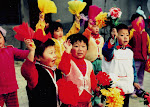 |
| A Qufu mother and baby in 1984 |
I visited Qufu, the ancestral home of Confucius, on my first
trip to China in 1984. We stayed
overnight in a quaint hotel on the edge of his family compound where we played ping
pong that afternoon. The next day, we toured the Confucius Temple. Back then,
Qufu had just opened up to foreigners, and we were quite an oddity. Wherever we
went, we drew crowds who would shyly touch us.
So I was pleased to see Qufu and the Confucius Temple placed
at the top of a CNN list of 15 must-see ancient places to see.
The Confucius Temple was built after the ancient Chinese
philosopher died in 479 BC. We toured the cemetery where he was buried. Today,
an estimated 100,000 of his Kong family descendents are buried there. The article notes his tomb is a pilgrimage site.
I haven’t been back to Qufu since then, but it’s on a list
of places in China I want to return to someday. While I was there, I took a
walk around the town, and snapped this picture of a proud Chinese mother and
her baby outside their simple home on a side street. She was so pleased I
wanted to photograph her and her baby. I often wonder what they are doing now.





